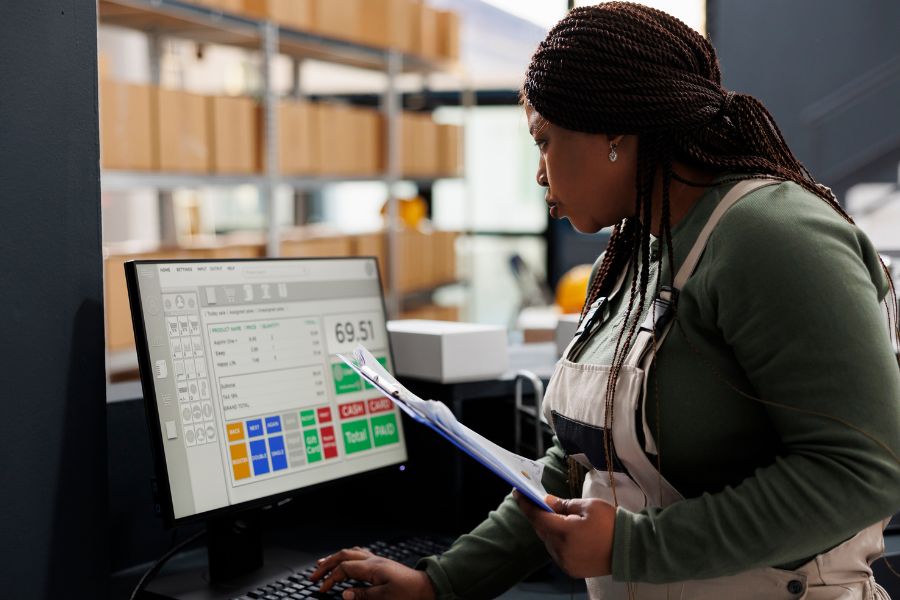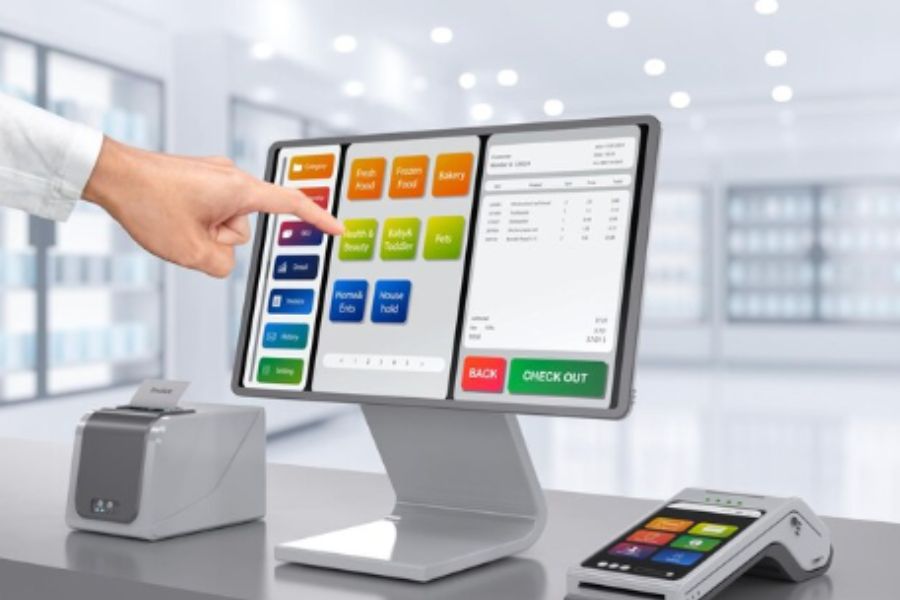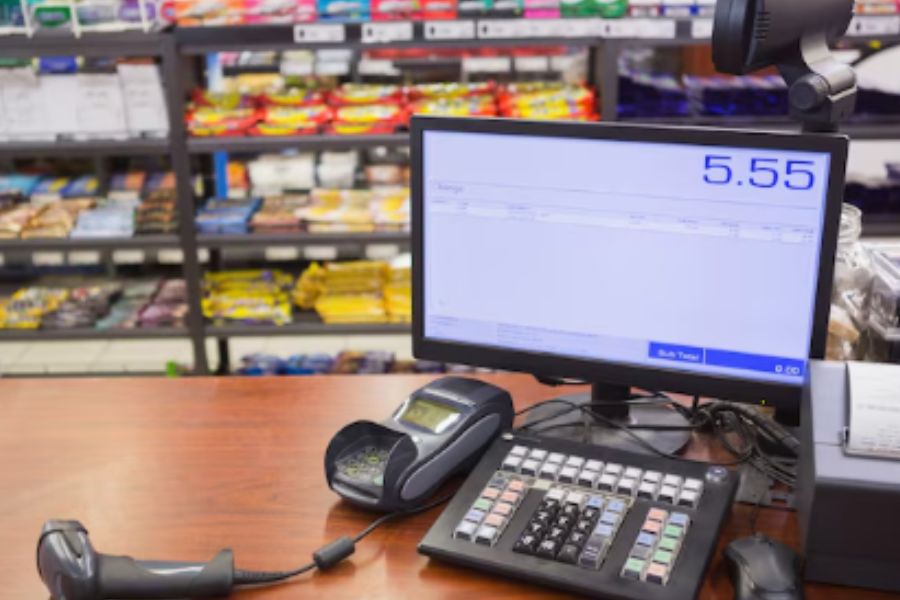Apparel inventory software has transformed how the fashion industry manages its supply chain. From handling raw materials to ensuring timely delivery to retailers, this technology provides unparalleled efficiency, transparency, and control. But what exactly does it do, and how does it track products from the factory floor to the hands of customers? This article dives into every step of the journey. Now, let’s explore!
Highlights:
- Apparel inventory software tracks every stage, from raw materials to final in-store availability, providing efficiency and accuracy.
- The future of apparel inventory software lies in integrating AI and advanced analytics for smarter decision-making, along with tools to drive sustainability and adapt to shifting consumer demands.
The Importance of Apparel Inventory Software
Apparel inventory software has become an integral part of the fashion industry, simplifying processes, improving operations, and driving profitability.
Optimizing Inventory Management
Apparel inventory software is specifically designed to address the unique challenges of the fashion industry. It effectively manages products that come in various variants, such as size, color, and style. This software provides real-time tracking of inventory levels, helping businesses avoid problems like overstocking or running out of high-demand items.
Enhanced Customer Experience
Happy customers are the heartbeat of any thriving business. With apparel inventory software seamlessly integrating with e-commerce platforms and point-of-sale (POS) systems, you can offer your customers real-time updates on stock availability. This means they’ll always have access to accurate information whether they’re shopping online or visiting your physical store. By minimizing the chances of selling out-of-stock items, you not only boost customer satisfaction but also foster lasting loyalty.
Data-Driven Decision Making
Apparel inventory software provides actionable insights through analytics and reporting tools. Businesses can analyze sales trends, identify best-selling products, and predict seasonal demands. These insights empower data-driven decisions, from restocking strategies to introducing new collections.
Streamlining Multichannel Operations
Balancing inventory across various sales channels can be a complex task. With centralized tracking, apparel inventory software ensures consistent stock information across physical stores, e-commerce platforms, and marketplaces, preventing mismatches and streamlining operations.
Reducing Manual Errors
Manual inventory management is time-consuming and prone to errors, especially in the apparel industry with its numerous product variations. Automation through software reduces human errors, saving time and ensuring inventory accuracy.
Cost and Time Efficiency
Automating inventory-related tasks like stock counting and reorder alerts, businesses save significant time and resources. The software also prevents losses associated with excess stock and missed sales opportunities, leading to better cost management.
Supporting Business Growth
Apparel inventory software helps businesses manage resources effectively by automating repetitive tasks and ensuring inventory aligns with demand. As businesses grow, the software can scale with them, accommodating larger volumes, additional products, and new sales channels with ease.
How Apparel Inventory Software Tracks the Journey
Let’s look at how apparel inventory software tracks this journey to reduce waste, meet customer demands, and maximize profitability.
Step 1: Keeping Raw Materials in Check
The process begins with managing raw materials like fabrics, zippers, and trims. Apparel inventory software monitors stock levels, records supplier details, and tracks lead times to avoid disruptions.
For example, a denim manufacturer can set inventory thresholds for fabric. When levels dip below a certain point, the system triggers automatic reorders, ensuring consistent production schedules without overstocking.
Step 2: Overseeing Production Processes
Once raw materials are procured, the software oversees production processes, from cutting and sewing to finishing. It tracks the flow of materials through various stages and allocates resources effectively.
A sportswear brand producing 10,000 units of a jacket can use the software to divide tasks across multiple factories. The system monitors progress in real-time, helping managers identify delays or bottlenecks.
Step 3: Maintaining Quality Control at Every Stage
Quality is paramount in apparel manufacturing. Inventory software ensures that quality control (QC) is maintained at each production stage by integrating QC checklists and defect tracking tools.
For instance, during the assembly of a batch of luxury handbags, the software logs QC results for stitching, zippers, and overall finish. If defects exceed an acceptable threshold, it raises alerts, and affected items are flagged for rework. This minimizes the risk of defective products reaching customers.
Step 4: Tracking Logistics and Transportation
After production, the focus shifts to logistics. Inventory software optimizes delivery schedules, tracks shipments in real-time, and reduces transit costs.
A fashion retailer shipping garments from Asia to the U.S. can use the software to track container shipments and monitor estimated arrival times. Integration with carriers like FedEx or DHL provides updates on delays, enabling quick adjustments.
Step 5: Managing Distribution to Retail and Warehouses
Apparel inventory software streamlines distribution by allocating stock efficiently between warehouses and retail stores based on demand patterns.
During Black Friday, a fast-fashion brand might see higher demand for winter coats in northern regions. The software analyzes sales data and ensures that sufficient inventory is sent to those locations. This prevents stockouts in high-demand areas while avoiding overstock in others.
Step 6: In-Store Inventory Monitoring
Once products reach stores, in-store inventory monitoring becomes crucial. Tools like ConnectPOS provide real-time inventory updates, enabling seamless stock management across locations.
Especially, ConnectPOS has many best features for in-store inventory monitoring such as:
- Real-Time Inventory Syncing: ConnectPOS ensures that inventory data is updated in real time across all stores, warehouses, and online platforms.
- Centralized Stock Visibility: With ConnectPOS, staff can instantly access inventory data from any location.
- Inventory Alerts and Replenishment: ConnectPOS generates alerts for low stock items, enabling timely replenishment. Businesses can set custom thresholds to maintain optimal stock levels.
- Omnichannel Integration: ConnectPOS seamlessly integrates in-store and online inventory, enabling click-and-collect, ship-from-store, or return-in-store services.
- Analytics and Reporting: The software provides detailed insights into sales trends, fast-moving items, and inventory turnover rates, helping businesses optimize stock planning.
With its robust features, ConnectPOS empowers retailers to optimize inventory management, ensure product availability, and deliver a seamless shopping experience.
Future of Apparel Inventory Software
The future of apparel inventory software is defined by technological advancements that address evolving industry challenges. As fashion businesses adapt to changing consumer expectations, innovations in inventory management are shaping more efficient, sustainable, and customer-centric operations.
- AI-Driven Inventory Forecasting
Artificial intelligence (AI) is transforming inventory management by enabling accurate demand forecasting. Advanced algorithms analyze historical sales data, market trends, and customer behavior to predict future demand. This minimizes overstocking, reduces waste, and optimizes inventory turnover.
For example, an AI-powered system can predict increased demand for winter coats in specific regions based on weather forecasts.
- Integration of IoT Technology
The Internet of Things (IoT) is enhancing real-time inventory tracking. RFID tags, smart shelves, and connected devices provide instant updates on stock movement.
For instance, RFID tags can instantly notify managers when stock levels fall below a threshold, triggering automated reorders.
- Sustainability and Circular Economy
As sustainability becomes a priority, inventory software is evolving to support eco-friendly practices. Features like tracking material usage, managing returns, and facilitating resale help brands adopt circular economy models. Retailers can use software to track product lifecycles, reducing waste and appealing to environmentally conscious consumers.
- Omnichannel Capabilities
Future inventory systems will focus heavily on omnichannel integration. Apparel businesses will rely on unified platforms to manage inventory across physical stores, e-commerce sites, and marketplaces.
This ensures consistent stock availability and enhances the customer experience with options like click-and-collect and ship-from-store.
- Cloud-Based and Scalable Solutions
Cloud-based software is becoming the norm, offering flexibility, scalability, and cost-efficiency. Small and medium-sized apparel businesses can benefit from subscription-based models, avoiding high upfront costs while accessing advanced features tailored to their growth.
- Enhanced Analytics and Insights
Future systems will offer deeper analytics, providing insights into customer preferences, sales trends, and operational efficiency. These insights empower businesses to make data-driven decisions, improving profitability and customer satisfaction.
FAQs: Apparel Inventory Software
- How does apparel inventory software integrate with other systems?
Apparel inventory software integrates with ERP, POS, and e-commerce platforms via APIs, enabling seamless data sharing. This integration ensures real-time updates across procurement, sales, and logistics, streamlining operations and reducing errors.
- What are the main challenges of implementing inventory software?
Challenges include high initial costs, employee resistance to new systems, and the need for extensive training. Additionally, integrating software with existing tools may require technical expertise and time, delaying full implementation.
- Is inventory tracking software costly for small businesses?
Many software options offer affordable pricing for small businesses, including tiered or subscription-based plans. Cloud-based solutions reduce upfront costs, making inventory tracking accessible and scalable without straining budgets.
Conclusion
Streamlined apparel inventory software is no longer just a competitive edge in today’s eCommerce landscape, it’s essential for business success. From raw material tracking to in-store inventory monitoring, this technology streamlines operations, reduces costs, and supports business growth.
Among the leading solutions, ConnectPOS stands out with its robust features like real-time inventory syncing, omnichannel integration, and actionable analytics. Feel free to contact us to book a personalized demo and experience the best features suitable for your business.



